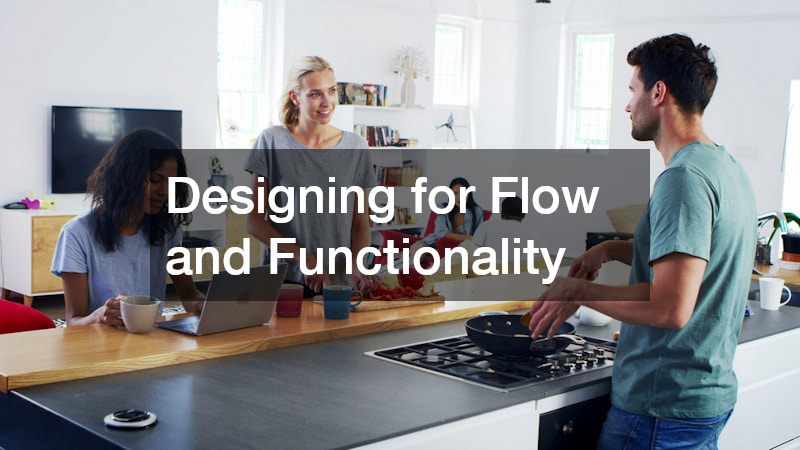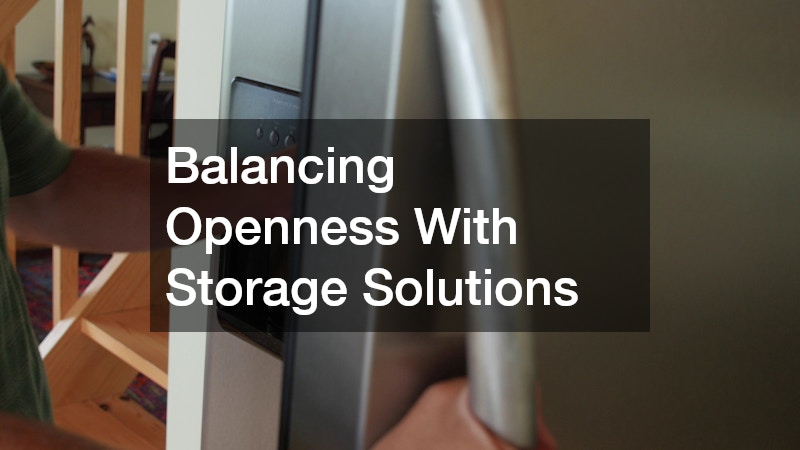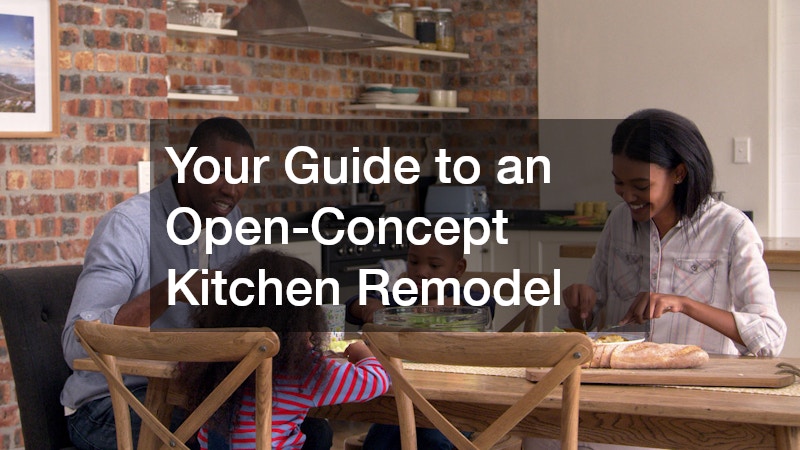Are you interested in an open-concept kitchen remodel? Check out our handy guide to make this dream a reality!

Benefits of an Open-Concept Kitchen
An open-concept kitchen has become one of the most sought-after remodeling choices for homeowners, and for good reason. By removing walls and barriers, the space instantly feels larger, brighter, and more inviting. This design encourages a seamless connection between the kitchen, dining, and living areas, making it easier for families to spend time together. Whether it’s preparing dinner while kids do homework at the table or entertaining guests without being cut off in a closed kitchen, the open concept allows for true interaction.
Another key benefit is the abundance of natural light. Without walls blocking windows or sightlines, sunlight can flow freely throughout the entire space, making the home feel warmer and more welcoming. Open-concept kitchens also add to a modern aesthetic, creating a clean, spacious look that appeals to potential buyers, which can boost your home’s resale value.
Practical benefits extend to improved traffic flow and flexibility. You can design zones for cooking, dining, and lounging without worrying about cramped walkways or isolated rooms. With the kitchen as the heart of the home, an open concept provides the perfect balance of functionality and style.
Ultimately, the biggest advantage is lifestyle-driven. Open-concept kitchens encourage togetherness, whether that means family dinners, parties with friends, or simply enjoying the daily rhythm of life without feeling boxed in. It’s not just about creating a beautiful kitchen design—it’s about improving how you live in your home.
Key Considerations Before You Start Remodeling
Before you begin tearing down walls for an open-concept kitchen remodel, it’s crucial to plan carefully. First, assess whether your home’s structure allows for it. Some walls may be load-bearing, meaning they support the weight of the house. Removing them often requires reinforcement with beams or columns, which can significantly increase costs. Consulting with a contractor or architect early ensures your remodel is safe and feasible.
Budget is another major factor. An open-concept kitchen remodel may involve more than just knocking down walls. You might need to reroute plumbing with the help of a local plumber, electrical wiring, and HVAC systems, which adds both time and money. Setting a realistic budget upfront—while leaving room for unexpected expenses—can save stress later.
Think about how you actually use your kitchen and living areas. An open-concept design works best if you value interaction, entertaining, and shared space. However, it may not suit those who prefer quiet cooking areas or want to contain cooking smells and mess. Noise can also travel more easily without walls, which might be a drawback for households with different activity levels happening simultaneously.
You’ll also want to consider storage. Removing walls often means losing cabinets, so planning alternative solutions like islands, pantries, or tall shelving becomes essential. Finally, think about how the remodel will connect the overall style of your home. Consistency in flooring, paint colors, and finishes ties the open space together for a cohesive design. With the right preparation, you’ll enter the kitchen remodeling process with clarity and confidence.

Designing for Flow and Functionality
For an open-concept kitchen remodel, design goes beyond aesthetics—it’s about creating a space that flows naturally and functions well for everyday life. Without walls separating rooms, the transition from one zone to another should feel seamless. That starts with considering how people move through the space. For example, placing the kitchen near the dining area and keeping pathways clear ensures meals can be served with ease.
The work triangle—stove, sink, and refrigerator—remains an important principle in open kitchens. This classic layout makes cooking efficient, but in an open-concept setting, you also need to think about how the kitchen connects to social areas. Positioning an island with seating can create a hub where food prep, conversation, and casual dining come together.
Functionality also extends to storage and appliances. Incorporating hidden storage in an island or under-counter kitchen cabinet shelves help maintain a clutter-free look. If you’re planning a large open space, consider adding a second sink or beverage station to make entertaining easier.
Flow applies to visual design as well. Flooring, color palettes, and lighting should guide the eye naturally from one area to the next. Repetition of materials—such as matching kitchen countertop stone with a fireplace surround—helps tie spaces together.
Ultimately, designing for flow and functionality means thinking about how your family lives day to day. From entertaining friends to weeknight dinners, your open-concept kitchen should feel intuitive, comfortable, and welcoming for every activity.
Choosing the Right Layout for Your Space
The foundation of any open-concept kitchen remodel is the layout. Since you’re working without traditional walls, the kitchen must blend smoothly with adjoining spaces. Start by identifying the “zones” you’ll need—cooking, cleaning, dining, and lounging. A good layout will balance these areas so they function without feeling crowded.
Islands are one of the most popular features in open layouts. They serve multiple purposes: meal prep, casual dining, homework space, or even extra storage. In some homes, a peninsula might work better than an island, especially in narrower spaces. Both options help define the kitchen while keeping it visually connected to the rest of the home.
Another consideration is traffic flow. Since open spaces often become gathering spots, make sure walkways remain at least 36 inches wide and appliance doors don’t block each other when opened. The kitchen should feel spacious without bottlenecks.
Your layout should also reflect your lifestyle. If you love entertaining, consider a design that keeps the cook involved in the action, perhaps with the range facing the living room. If family dinners are central to your routine, ensure the dining space is easily accessible.
By tailoring your layout to your habits and the architecture of your home, you’ll create an open-concept kitchen remodel that’s both stylish and highly functional.

Balancing Openness With Storage Solutions
One of the biggest challenges in an open-concept remodel is maintaining enough storage. When walls come down, so do upper cabinets. This loss can create clutter unless you plan carefully. Luckily, there are plenty of ways to blend openness with smart storage.
Islands are storage workhorses, offering drawers, shelves, and cabinets for pots, pans, small appliances, and other kitchen accessories. Consider incorporating pull-out organizers, hidden trash bins, or deep drawers for cookware. Open shelving can also add style while keeping essentials within easy reach.
For families with larger storage needs, a walk-in or butler’s pantry can provide the perfect solution. Pantries allow you to tuck away bulk groceries, countertop appliances, and even coffee stations, leaving your main kitchen clean and streamlined.
Built-in cabinetry in nearby dining or living areas can also extend storage. For example, a sideboard along the dining wall can house dishes, linens, and serving pieces without cluttering the kitchen. Multifunctional furniture—like benches with hidden compartments—adds further flexibility.
The key is finding a balance. Too much cabinetry can overwhelm the airy feel of an open space, while too little leads to chaos. Combining concealed storage with display shelving creates a practical yet inviting environment. By planning ahead, you’ll keep your open kitchen organized while maintaining its sleek, uncluttered look.
Lighting Ideas to Brighten Your Open Kitchen
Lighting is a powerful design tool, especially in an open-concept kitchen remodel where one fixture won’t suffice. A layered lighting plan ensures the entire space feels bright, welcoming, and functional.
Start with ambient lighting. Recessed ceiling lights or flush mounts provide general illumination across the room. Next, have your kitchen remodeling service add task lighting over specific work areas like countertops, islands, and sinks. Pendant lights are a favorite for islands because they combine function with style, serving as decorative focal points.
Under-cabinet lighting is another must-have. It brightens food prep areas, reduces shadows, and adds a subtle glow in the evenings. In an open layout, dimmable fixtures are especially valuable, allowing you to adjust brightness for cooking, entertaining, or relaxing.
Don’t overlook natural light. Large windows, skylights, or sliding glass doors maximize daylight, reducing the need for artificial light during the day. When possible, align your remodel to take advantage of natural light sources.
Finally, consider accent lighting to highlight design features. LED strips along floating shelves, cabinet toe-kicks, or architectural details can elevate the overall look. Mixing light sources ensures your open kitchen is versatile—bright for cooking, soft for dining, and dramatic for entertaining.

Flooring Options That Create a Seamless Look
Flooring sets the tone in an open-concept kitchen remodel, serving as the unifying element between different areas. The best approach is to use consistent flooring throughout the kitchen, dining, and living spaces. This creates a seamless, uninterrupted look that visually enlarges the room.
Hardwood remains a timeless choice. It offers warmth, durability, and versatility, complementing both modern and traditional styles. Engineered hardwood is particularly popular for kitchens because it resists moisture better than solid wood. For a more budget-friendly option, luxury vinyl plank mimics the look of wood while being highly durable and water-resistant.
Tile is another strong option, especially for homeowners who want easy cleanup and resistance to spills. Large-format porcelain tiles or natural stone can bring elegance while maintaining durability. However, tile can feel cold, so radiant floor heating may be worth considering.
Concrete is rising in popularity for its industrial aesthetic and long-lasting nature. When polished or stained, it can look sleek and modern while withstanding heavy use.
No matter which material you choose, pay attention to color and texture with the help of professional remodeling services. Neutral tones and smooth transitions keep the open layout cohesive. Area rugs can be used strategically to define zones without breaking the flow. Ultimately, the right flooring should balance practicality with the overall design vision of your open-concept remodel.
Selecting Appliances That Complement the Design
Appliances play a dual role in an open-concept kitchen remodel; they must perform well while blending seamlessly into the design. Because everything is visible in an open-concept layout, oversized or outdated appliances can easily disrupt the look.
Integrated or panel-ready appliances are ideal for maintaining a streamlined appearance. These models allow you to cover refrigerators or dishwashers with cabinet panels, so they blend in with surrounding cabinetry. Sleek stainless steel appliances remain popular, but matte black or custom finishes are increasingly common in modern remodels.
When selecting appliances, think about functionality as much as aesthetics. For example, double ovens or a large cooktop may be useful if you entertain often. An oversized fridge might be essential for a growing family, while smaller households may prefer compact appliances to save space.
Noise is another key factor. Since the kitchen flows into living areas, quiet dishwashers and vent hoods prevent unwanted disruption. Energy efficiency should also guide your choices, reducing long-term operating costs.
Placement is equally important. A well-placed microwave drawer or beverage fridge in the island adds convenience without clutter. By aligning your appliance choices with your lifestyle and design goals, you’ll create a kitchen that feels cohesive and practical.

Adding Personality Through Finishes and Fixtures
The beauty of an open-concept kitchen remodel lies in its versatility, and finishes and fixtures are where you can truly express your style. Cabinets, hardware, countertops, and backsplashes all provide opportunities to make the space unique.
Start with your cabinets. Two-tone designs—like navy lowers paired with white uppers—add contrast and dimension. Hardware choices, such as brushed brass or matte black handles, can make a big visual statement. Countertops are another focal point during a home renovation. Quartz is durable and low-maintenance, while natural stone like marble or granite offers timeless elegance.
Backsplashes give you creative freedom. Subway tile is a classic option, but geometric patterns, bold colors, or even glass panels can bring a contemporary edge. Lighting fixtures also act as jewelry for the kitchen. Statement pendants above an island or a sculptural chandelier in the dining area draw the eye and set the mood.
Don’t forget about soft finishes like rugs, barstools, and artwork. These pieces tie the kitchen into adjoining spaces while adding warmth and personality. Even small details, such as faucet style or sink finish, can shift the overall feel. By mixing textures, colors, and finishes thoughtfully, your open-concept kitchen becomes more than functional—it becomes a reflection of your personality and lifestyle.
Ready to design an open-concept kitchen remodel? With the right professional kitchen remodeling contractor by your side, your new cooking, dining, and entertaining space will be gorgeous. Use these tips to get started!
